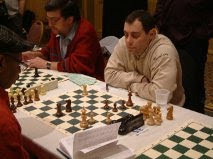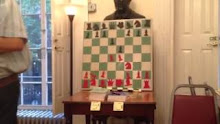Here Byrne considered only 16...Kc8 which leads to slaughter after 17.Qe8+! Qd8 18.Qxf7 Bxd5 19.Qxd5 Nxd5 20.Bxd8 Kxd8 21.Be4 N5b6 22.Bxa8 Nxa8 23.Nxd6.
But what is wrong with 16...Qc5!, I wondered. Being only a Class C player at the time, I lacked the confidence to mail my suggestion to any chess periodicals. Some years later, in the September 1976 issue of Chess Life & Review, grandmaster Leonid Shamkovich included in his column the game Blumenfeld-DeFirmian, Lone Pine 1976 which proceeded 16...Qc5! 17.Qd2 Rc8 18.Kb1 Kc7 and "White's attack dried up."
It was right then and there that I made up my mind to become a chess master and a chess journalist!
{This article originally appeared in the Fall 2000 issue of Empire Chess}




























